The Sleep Movement Disorders Market is estimated to be valued at USD 1.2 billion in 2025 and is projected to reach USD 2.1 billion by 2035, registering a compound annual growth rate (CAGR) of 6.0% over the forecast period.
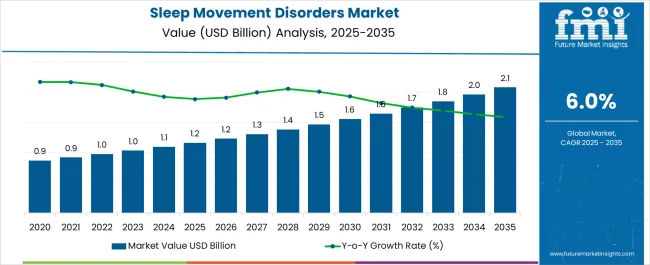
| Metric | Value |
|---|---|
| Sleep Movement Disorders Market Estimated Value in (2025E) | USD 1.2 billion |
| Sleep Movement Disorders Market Forecast Value in (2035F) | USD 2.1 billion |
| Forecast CAGR (2025 to 2035) | 6.0% |
The Sleep Movement Disorders market is experiencing steady growth driven by increasing awareness and diagnosis of conditions such as restless legs syndrome and periodic limb movement disorder. The market expansion is supported by rising prevalence of sleep-related neurological disorders across both developed and emerging regions. Advances in therapeutic approaches and the growing adoption of pharmacological interventions have enabled better management of symptoms, contributing to market growth.
Increasing investments in healthcare infrastructure and patient education programs are further facilitating the uptake of treatment options. As the demand for quality of life improvements in patients with sleep movement disorders grows, the market is witnessing enhanced focus on drug development and optimized distribution strategies.
Technological advancements in monitoring and diagnostic tools are also helping clinicians identify patients earlier and tailor treatments more effectively The combination of improved disease awareness, innovative therapies, and accessible healthcare delivery is anticipated to sustain long-term growth in the Sleep Movement Disorders market, with continuous opportunities for both established and emerging pharmaceutical companies.
The sleep movement disorders market is segmented by drug class, sleep movement disorder type, distribution channel, and geographic regions. By drug class, sleep movement disorders market is divided into Dopaminergic Agonists, Benzodiazepines, Opioids, Anticonvulsants, and Others. In terms of sleep movement disorder type, sleep movement disorders market is classified into Restless Legs Syndrome, Periodic Limb Movement Disorder (PLMD), Sleep Leg Cramps, Sleep Rhythmic Movement, and Sleep Bruxism. Based on distribution channel, sleep movement disorders market is segmented into Retail Pharmacies, Hospital Pharmacies, e-Commerce, and Others. Regionally, the sleep movement disorders industry is classified into North America, Latin America, Western Europe, Eastern Europe, Balkan & Baltic Countries, Russia & Belarus, Central Asia, East Asia, South Asia & Pacific, and the Middle East & Africa.
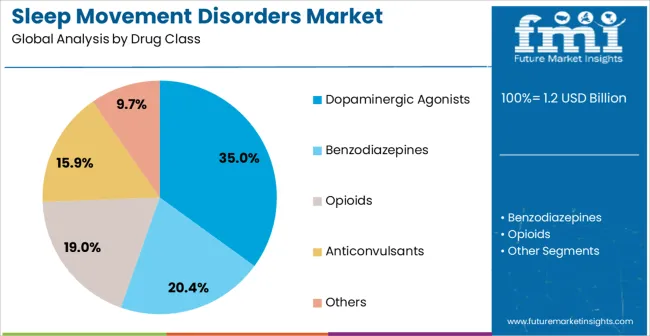
The Dopaminergic Agonists drug class is projected to hold 35.00% of the Sleep Movement Disorders market revenue share in 2025, establishing it as the leading pharmacological treatment segment. This dominance is attributed to the proven efficacy of these agents in alleviating symptoms of restless legs syndrome and other sleep movement disorders. The growth of this segment has been supported by widespread adoption among patients and clinicians due to the predictable response profile, manageable side effects, and ability to improve patient quality of sleep.
Continuous advancements in formulation and targeted delivery methods have enhanced the therapeutic impact, making dopaminergic agonists highly preferred in clinical practice. The segment’s expansion has also been reinforced by long-term treatment adherence driven by symptom improvement and patient comfort.
Additionally, the availability of these agents through standard prescription channels has facilitated accessibility, further strengthening their market position Future growth is expected to be supported by ongoing research in optimizing dosing strategies and extending applications to broader patient populations.
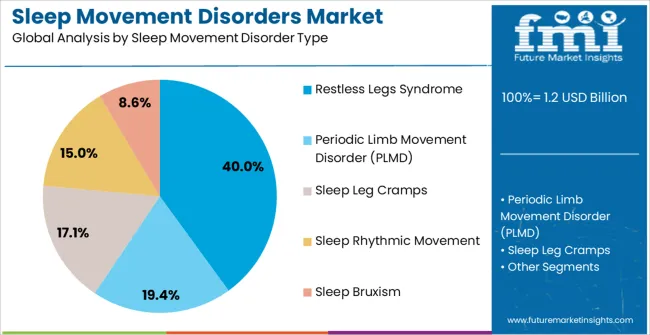
The Restless Legs Syndrome disorder type is anticipated to account for 40.00% of the Sleep Movement Disorders market revenue share in 2025, emerging as the dominant condition segment. The leadership of this segment is being driven by the high prevalence of restless legs syndrome among adults and its significant impact on sleep quality, productivity, and overall quality of life.
Increased disease awareness among healthcare providers and patients has led to more diagnoses and earlier interventions, which in turn fuels demand for effective therapies. Growth is further supported by the availability of multiple treatment options, including pharmacological and non-pharmacological approaches that can be tailored to patient needs.
The segment’s prominence is reinforced by rising adoption of dopaminergic agonists and other first-line therapies, which have shown consistent efficacy in managing symptoms Ongoing clinical research and improved patient support programs are expected to maintain the segment’s leading position by ensuring sustained treatment adherence and improving therapeutic outcomes in restless legs syndrome patients.
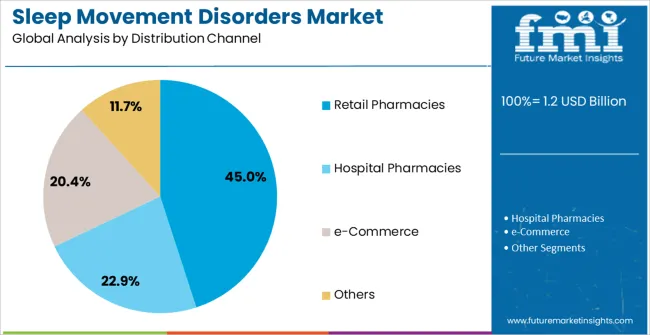
The Retail Pharmacies distribution channel is expected to capture 45.00% of the Sleep Movement Disorders market revenue share in 2025, positioning it as the primary channel for delivering treatments to patients. This leading role is being supported by the convenience, accessibility, and widespread presence of retail pharmacy networks, which allow patients to obtain medications efficiently and reliably.
The growth of this channel has been reinforced by strong relationships with healthcare providers, enabling seamless prescription fulfillment and patient education. Retail pharmacies also offer personalized guidance on medication adherence, side effect management, and treatment optimization, which enhances patient satisfaction and therapeutic outcomes.
In addition, the ability to stock a broad range of dopaminergic agonists and other treatment options ensures that patients have timely access to their prescribed therapies The expanding reach of retail pharmacy chains and their integration with healthcare systems is expected to sustain the segment’s market leadership by ensuring availability, convenience, and high patient engagement in the management of sleep movement disorders.
Sleep movement disorders are the disorders disrupting during sleep and generally have undesirable verbal or physical behaviors which frequently result in insomnia and daytime fatigue. Movements during sleep are very common, especially among children.
Sleep movement disorders occur in association with sleep during the specific sleep stages. Sleep movement disorders are a class of self-limited clinical conditions which are difficult to diagnose and treat. The classification of sleep movement disorders includes conditions that cause movement during sleep.
Some of the major conditions are: restless legs syndrome, sleep rhythmic movement, periodic limb movement disorder, sleep leg cramps, and sleep bruxism. Amongst them, restless legs syndrome and periodic limb movement disorder are the most common disorder.
Restless legs syndrome is characterized by unpleasant sensations deep inside the legs. Periodic limb movement disorder is characterized by rhythmic movements of the limbs during sleep. Approximately 80% of patients with restless legs syndrome have a periodic limb movement disorder.
Symptoms of sleep movement disorders include fragmented or broken sleep, daytime fatigue, and non-refreshing sleep. Sleep movement disorders are generally diagnosed with polysomnography. Polysomnography test records brain waves, the oxygen level in blood, heart rate and breathing, eye, and leg movements. Polysomnography is usually conducted in laboratory/clinics and in-home care settings.
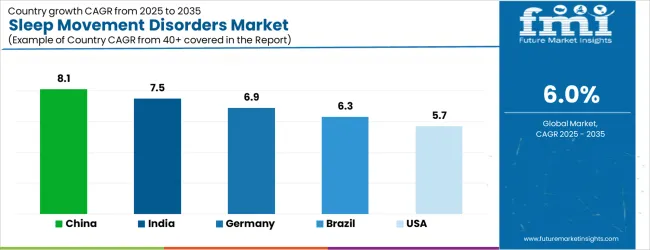
| Country | CAGR |
|---|---|
| China | 8.1% |
| India | 7.5% |
| Germany | 6.9% |
| Brazil | 6.3% |
| USA | 5.7% |
| UK | 5.1% |
| Japan | 4.5% |
The Sleep Movement Disorders Market is expected to register a CAGR of 6.0% during the forecast period, exhibiting varied country level momentum. China leads with the highest CAGR of 8.1%, followed by India at 7.5%. Developed markets such as Germany, France, and the UK continue to expand steadily, while the USA is likely to grow at consistent rates. Japan posts the lowest CAGR at 4.5%, yet still underscores a broadly positive trajectory for the global Sleep Movement Disorders Market.
In 2024, Germany held a dominant revenue in the Western Europe market and is expected to grow with a CAGR of 6.9%. The USA Sleep Movement Disorders Market is estimated to be valued at USD 397.2 million in 2025 and is anticipated to reach a valuation of USD 397.2 million by 2035. Sales are projected to rise at a CAGR of 0.0% over the forecast period between 2025 and 2035. While Japan and South Korea markets are estimated to be valued at USD 57.0 million and USD 39.9 million respectively in 2025.
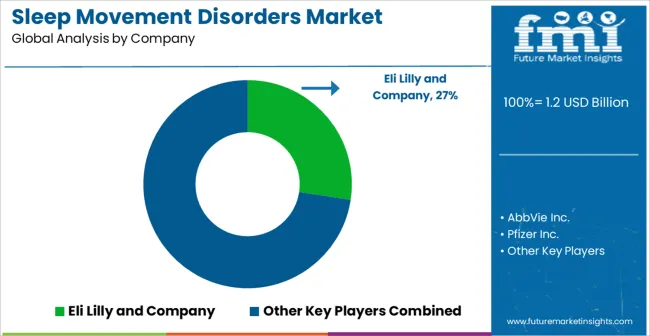
| Item | Value |
|---|---|
| Quantitative Units | USD 1.2 Billion |
| Drug Class | Dopaminergic Agonists, Benzodiazepines, Opioids, Anticonvulsants, and Others |
| Sleep Movement Disorder Type | Restless Legs Syndrome, Periodic Limb Movement Disorder (PLMD), Sleep Leg Cramps, Sleep Rhythmic Movement, and Sleep Bruxism |
| Distribution Channel | Retail Pharmacies, Hospital Pharmacies, e-Commerce, and Others |
| Regions Covered | North America, Europe, Asia-Pacific, Latin America, Middle East & Africa |
| Country Covered | United States, Canada, Germany, France, United Kingdom, China, Japan, India, Brazil, South Africa |
| Key Companies Profiled | Eli Lilly and Company, AbbVie Inc., Pfizer Inc., Merck & Co. Inc., Sanofi, Bristol-Myers Squibb Company, Johnson & Johnson, and AstraZeneca |
The global sleep movement disorders market is estimated to be valued at USD 1.2 billion in 2025.
The market size for the sleep movement disorders market is projected to reach USD 2.1 billion by 2035.
The sleep movement disorders market is expected to grow at a 6.0% CAGR between 2025 and 2035.
The key product types in sleep movement disorders market are dopaminergic agonists, benzodiazepines, opioids, anticonvulsants and others.
In terms of sleep movement disorder type, restless legs syndrome segment to command 40.0% share in the sleep movement disorders market in 2025.






Full Research Suite comprises of:
Market outlook & trends analysis
Interviews & case studies
Strategic recommendations
Vendor profiles & capabilities analysis
5-year forecasts
8 regions and 60+ country-level data splits
Market segment data splits
12 months of continuous data updates
DELIVERED AS:
PDF EXCEL ONLINE
Sleep Study Equipment Market Size and Share Forecast Outlook 2025 to 2035
Sleep Supplement Market Size and Share Forecast Outlook 2025 to 2035
Sleep Tracking and Optimization Products Market Size and Share Forecast Outlook 2025 to 2035
Sleep Study Market Analysis – Size, Share, and Forecast Outlook 2025 to 2035
Sleep Apnea Diagnostic Systems Market Analysis - Size, Share, and Forecast Outlook 2025 to 2035
Sleep Apnea Implants Market Analysis – Size, Share & Forecast 2025-2035
Sleeper Pads Market Size and Share Forecast Outlook 2025 to 2035
Sleep Apnea Devices Market Overview - Trends & Growth Forecast 2025 to 2035
Sleep Screening Devices Market Trends and Forecast 2025 to 2035
Sleep Gummy Market Analysis by Primary Ingredient, Customer Orientation, Pack Size and Product Claim Through 2035
Key Players & Market Share in the Sleep Apnea Implants Industry
Key Players & Market Share in the Sleeping Bag Industry
Sleeping Bag Market Analysis – Trends, Growth & Forecast 2024-2034
Sleep Aid Devices Market Growth – Industry Insights & Forecast 2022-2032
Home Sleep Screening Device Market Size and Share Forecast Outlook 2025 to 2035
Home Sleep Apnea Testing Market Analysis - Size, Share, and Forecast Outlook 2025 to 2035
Short sleep syndrome Treatment Market Growth & Demand 2025 to 2035
China Sleep Apnea Diagnostic Systems Market Outlook – Size, Share & Growth 2025-2035
Japan Sleep Apnea Diagnostic Systems Market Report – Size, Demand & Outlook 2025-2035
France Sleep Apnea Diagnostic Systems Market Insights – Size, Share & Demand 2025-2035

Thank you!
You will receive an email from our Business Development Manager. Please be sure to check your SPAM/JUNK folder too.
Chat With
MaRIA